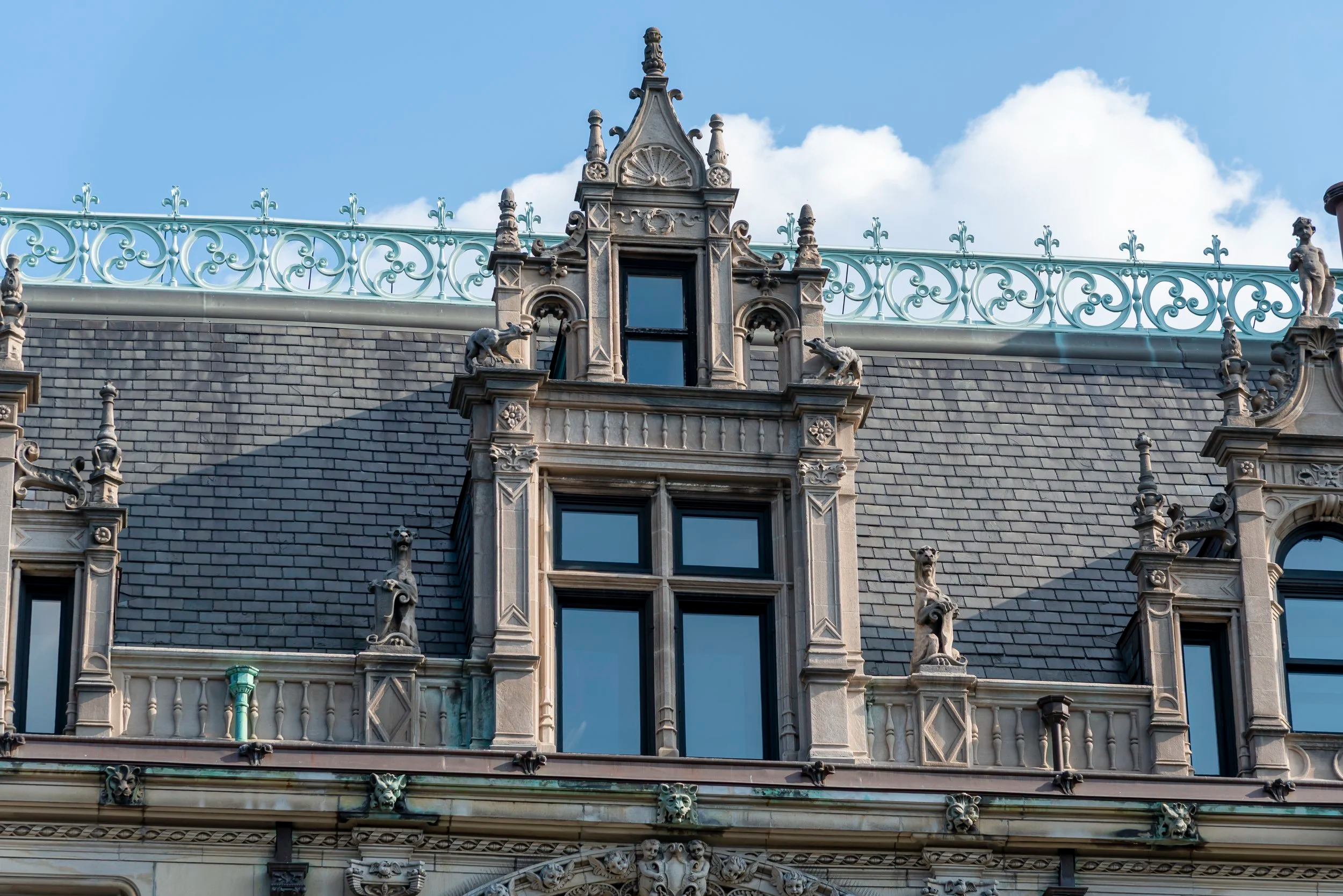Burrage Mansion
314 Commonwealth Avenue, Back Bay, Boston
314 Commonwealth Avenue, better known as the Burrage Mansion, occupies the southwest corner of Commonwealth and Hereford Streets, where it has stood as one of the Back Bay’s most imposing and recognizable landmarks for more than a century. Designed by architect Charles Brigham and constructed between 1899 and 1900 by the firm of Lyman D. Willcutt & Son, the house was commissioned by industrialist and philanthropist Albert Cameron Burrage and his wife, Alice Hathaway Haskell Burrage (Boston Herald, July 16, 1899; Boston Globe, Oct. 27, 1901).
The site Burrage chose was unusually large by Back Bay standards, with a frontage of more than fifty-five feet on Commonwealth Avenue. It combined two separate parcels: a vacant corner lot at Hereford Street and the adjoining townhouse lot at 316 Commonwealth. Alice Burrage purchased both in January 1899 from real estate dealer James Goldthwaite Freeman, who had acquired the land earlier that same week. The townhouse at 316 was promptly demolished to make way for the new mansion (Suffolk County Registry of Deeds, 1899).
The lot itself had a long history. It had once been part of a larger tract owned by Nathan Matthews and later managed by trustees Caleb H. Warner and Charles F. Smith, who subdivided and sold it in the 1870s. By the time Alice Burrage acquired it, ownership had passed through a series of Boston merchants and investors, including ship broker Frank Newton Thayer and financier Horatio Hollis Hunnewell. Deed restrictions attached to the sale required that any new structure be a dwelling house not exceeding four and a half stories, an agreement intended to preserve the character of the neighborhood and protect the views from the Sargent family’s home directly across Hereford Street (Suffolk County Registry of Deeds, 1879–1899).
Construction of the Burrage Mansion moved quickly. By mid-1899, the Boston Herald reported that the “handsome residence” had already reached its second story. Sculptor Hugh Cairns was commissioned to design and model much of the exterior ornament, creating carved details in stone directly on site. Brigham himself kept an office at the construction site to supervise the work. By late 1900, the house was finished, and in the winter season of 1900–1901 the Burrage family moved in after briefly residing at the newly built Hotel Somerset (Boston Herald, July 16, 1899; Boston Globe, Oct. 27, 1901).
Albert Burrage was a prominent Boston attorney and businessman, who rose to national prominence in the copper industry. He helped organize the Amalgamated Copper Company, a powerful trust that later became the Chile Copper Company, and held interests in gas, chemicals, and dyes. He was also a noted horticulturalist, building a one-story glass conservatory at the rear of 314 Commonwealth and later publishing on his passion for orchids. Beyond his Boston mansion, Burrage built or purchased estates in Cohasset, Manchester-by-the-Sea, and Redlands, California, many designed by leading architects of the day (Boston Globe, Sept. 21, 1899; Boston Globe, May 20, 1911).
The Burrages raised four children in the mansion: Albert Jr., Francis, Russell, and Elizabeth. Their lives, like their father’s career, were tied to Harvard and to Boston society. Albert Jr. became a mining engineer and later an author on horticulture. Francis briefly worked in banking before his untimely death in 1911. Russell entered the munitions industry, and Elizabeth married Harold Chalifoux of the well-known retail family (Harvard University Archives; Boston Globe, 1911–1916).
The Burrages also maintained an active philanthropic presence. Albert endowed hospitals, including a facility for children on Bumpkin Island in Boston Harbor, which opened in 1902 and later served as a polio treatment center before its destruction by fire in 1946. He also supported botanical projects and civic initiatives in Boston (Boston Globe, July 1, 1902).
Albert Burrage died in 1931, but Alice continued to reside in the mansion and at the family’s Manchester estate until her death in 1947. In her will, she left Seahome in Manchester to her daughter, while providing her the option to purchase 314 Commonwealth outright. Elizabeth Chalifoux did so, but almost immediately transferred the mansion to a development company that converted it from a private home into medical offices. This marked the beginning of a long period of institutional use (Suffolk County Registry of Deeds, 1948).
In the mid-twentieth century the mansion cycled through new identities. It served as medical offices, later as the Boston Evening Clinic and Hospital, and eventually as a nursing home and elder care facility. Despite interior alterations, many of the house’s architectural flourishes survived. In the early 2000s, preservation agreements ensured that the entry vestibule, grand stair, and second-floor hall would remain intact. In 2003, the building was formally converted into five luxury condominiums under the name Burrage Mansion Condominium (Boston City Archives, 2003).
During the condominium era, the property attracted notable residents. Among them was New England Patriots quarterback Tom Brady, who owned one of the units from 2004 until 2008. His residency added a modern celebrity chapter to a house already steeped in Boston’s industrial and cultural history (Boston Magazine, 2008).
Today, the Burrage Mansion remains one of the most remarkable private residences in Boston. Its limestone façade, sculpted ornament, and imposing bulk set it apart from the rowhouses that flank Commonwealth Avenue. Inside, restored details such as elaborate plaster ceilings, carved fireplaces, and stained glass recall the grandeur of Boston’s Gilded Age. More than a century after Albert and Alice Burrage built their home, 314 Commonwealth continues to represent both the ambition of its first owners and the endurance of Back Bay’s architectural heritage.




